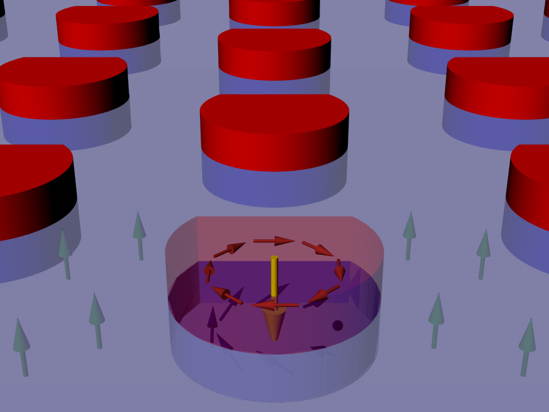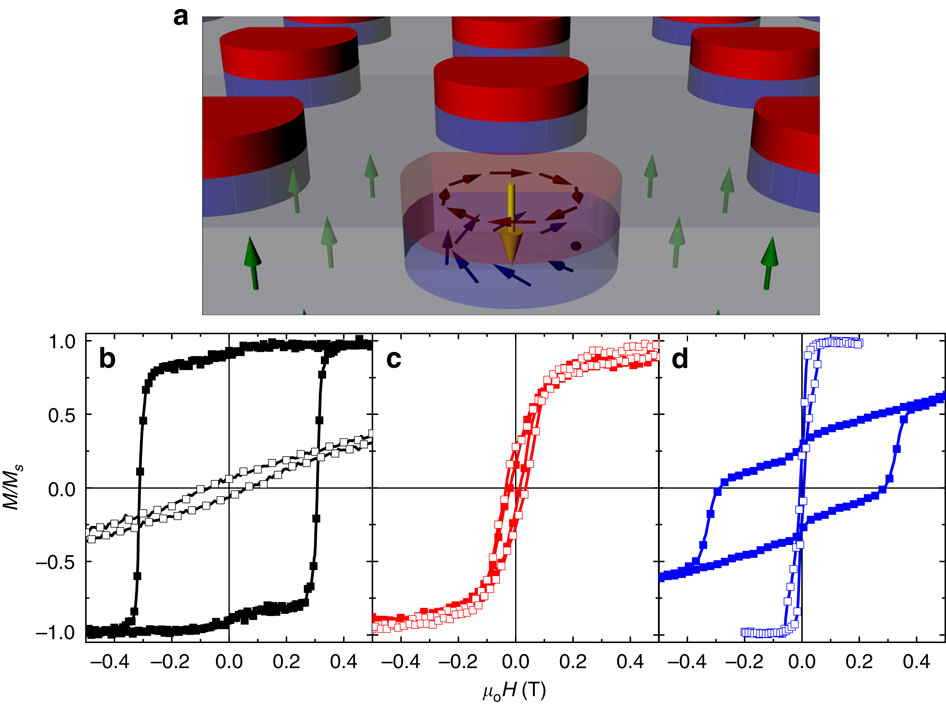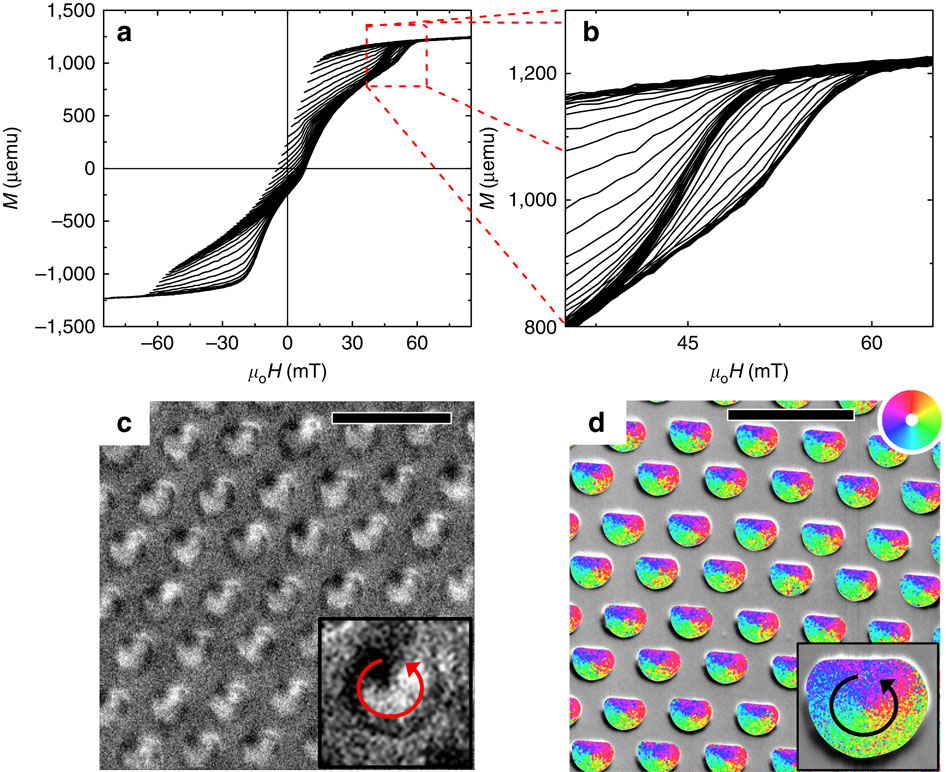NIST and UC Davis Scientists Float New Approach to Creating Computer Memory
Brings skyrmions step closer for use in real-world storage as well as other novel magnetic and electronic technologies.
This is a Press Release edited by StorageNewsletter.com on October 14, 2015 at 2:39 pmWhat can skyrmions do for you? These ghostly quantum rings, heretofore glimpsed only under extreme laboratory conditions, just might be the basis for a new type of computer memory that never loses its grip on the data it stores.
A magnetized cobalt disk (red) placed atop a thin cobalt-palladium film
(light purple background) can be made to confer its own ringed
configuration of magnetic moments (orange arrows) to the film below,
creating a skyrmion in the film (purple arrows). The skyrmion, which is stable
at room temperature, might be usable in computer memory systems.
(Credit: Dustin Gilbert, NIST)
Now, thanks to a research team including scientists from the National Institute of Standards and Technology (NIST), (*) the exotic ring-shaped magnetic effects have been coaxed out of the physicist’s deepfreeze with a straightforward method that creates magnetic skyrmions under ambient room conditions. The achievement brings skyrmions a step closer for use in real-world storage as well as other novel magnetic and electronic technologies.
If you have a passing familiarity with particle physics, you might expect skyrmions to be particles; after all, they sound a lot like fermions, a class of particles that includes protons and neutrons. But skyrmions are not fundamental pieces of matter (not even of yogurt); they are effects named after the physicist who proposed them. Until just recently, magnetic skyrmions had only been seen at very low temperatures and under powerful magnetic fields.
The magnetic force in each individual atom in a magnet – what physicists call their ‘magnetic moments’- all line up the same way, like tiny compasses all pointing in the same direction. But under extreme conditions, certain magnetic materials (such as MnSi or FeCoSi) can, instead, develop spots where the moments curve and twist, forming a winding, ring-like configuration. These unusual objects possess an elasticity that protects them from outside influence, meaning the data they store would not be corrupted easily, even by stray magnetic fields or physical defects within the material. As a result, magnetic skyrmions present a promising basis for information memory systems and other nanoelectronic devices.
A hurdle in using traditional skyrmions was the extreme lab conditions needed to form them. Until recently, scientists glimpsed magnetic skyrmions only at low temperatures. While NIST’s Dustin Gilbert was a graduate student in Kai Liu’s lab at the University of California, Davis, he and Liu not only designed an approach to make the quantum objects, but also their creations remained stable at room temperature, with no magnetic field.
It took a trip to NIST to confirm the skyrmions’ existence. Creating them involves placing arrays of tiny magnetized cobalt disks atop a thin film made of cobalt and palladium; the NIST Center for Neutron Research (NCNR) had just developed a state-of-art polarized neutron reflectometer that was well suited to study their lab results. Working with NCNR scientists, the team used neutrons to see through the disk to spot the skyrmions underneath. The team also captured images of the whirling configurations in the disk array at NIST’s Center for Nanoscale Science and Technology (CNST) and Lawrence Berkeley Laboratory.
According to Gilbert, the findings should interest anyone following spintronics, a field that aims to use magnetic effects such as those skyrmions exhibit for information storage and processing. “The idea that has been discussed is that, for example, you could just push these stable magnetic bundles in single file down a line and read their data. The advantage here is that you’d need way less power to push them around than any other method proposed for spintronics,” says Gilbert, who recently began a postdoctoral fellowship at the NCNR. “What we need to do next is figure out how to make them move around. But for now, we can start exploring how we might use skyrmions in technology – the playground is open.“
The research was supported by the National Science Foundation.
(*) D.A. Gilbert, B.B. Maranville, A.L. Balk, B.J. Kirby, P. Fischer, D.T. Pierce, J. Unguris, J.A. Borchers and K. Liu. Realization of Ground State Artificial Skyrmion Lattices at Room Temperature. Nature Communications, 6:8462, doi: 10.1038/ncomms9462 (2015).
Article reference:
Nature Communications has published the article written by Dustin A. Gilbert, Department of Physics, University of California, Davis, California 95616, USA, and NIST Center for Neutron Research, National Institute of Standards and Technology, Gaithersburg, Maryland 20899, USA, Brian B. Maranville, NIST Center for Neutron Research, National Institute of Standards and Technology, Gaithersburg, Maryland 20899, USA , Andrew L. Balk, Center for Nanoscale Science and Technology, National Institute of Standards and Technology, Gaithersburg, Maryland 20899, USA and Maryland Nanocenter, University of Maryland, College Park, Maryland 20742, USA, Brian J. Kirby, NIST Center for Neutron Research, National Institute of Standards and Technology, Gaithersburg, Maryland 20899, USA, Peter Fischer, Center for X-Ray Optics, Lawrence Berkeley National Laboratory, Berkeley, California 94720, USA and Department of Physics, University of California, Santa Cruz, California 94056, USA, Daniel T. Pierce, John Unguris, Center for Nanoscale Science and Technology, National Institute of Standards and Technology, Gaithersburg, Maryland 20899, USA , Julie A. Borchers, NIST Center for Neutron Research, National Institute of Standards and Technology, Gaithersburg, Maryland 20899, USA and Kai Liu, Department of Physics, University of California, Davis, California 95616, USA.
(a) The hybrid structure consists of Co dots (red) on top of Co/Pd PMA
underlayer (grey) where the in-plane spin texture of the Co dots (purple arrows)
is imprinted into an irradiated Co/Pd region (light blue) underneath the dots
(tilted blue arrows). Green and yellow arrows indicate the moments in the Co/Pd
underlayer and the core region of the (imprinted) vortex, respectively.
Major in-plane (open symbols) and perpendicular (solid symbols) hysteresis
loops are shown for (b) the Co/Pd underlayer as grown, (c)
the irradiated Co/Pd witness sample and (d) the hybrid Co+Co/Pd sample.
(a) Family of FORCs of the hybrid sample measured in the in-plane geometry.
The zoomed-in view in (b) illustrates essentially two discrete vortex annihilation fields.
Remanent-state (c) MFM and (d) SEMPA (superimposed onto a scanning electron
microscopy image of the dots) images, after saturating the dots in an in-plane field
parallel to the flat edge of the dots to the right, indicate circularity control.
Scale bar, 2 μm. A key to the magnetization winding direction is shown in the insets.
Abstract: “The topological nature of magnetic skyrmions leads to extraordinary properties that provide new insights into fundamental problems of magnetism and exciting potentials for novel magnetic technologies. Prerequisite are systems exhibiting skyrmion lattices at ambient conditions, which have been elusive so far. Here, we demonstrate the realization of artificial Bloch skyrmion lattices over extended areas in their ground state at room temperature by patterning asymmetric magnetic nanodots with controlled circularity on an underlayer with perpendicular magnetic anisotropy (PMA). Polarity is controlled by a tailored magnetic field sequence and demonstrated in magnetometry measurements. The vortex structure is imprinted from the dots into the interfacial region of the underlayer via suppression of the PMA by a critical ion-irradiation step. The imprinted skyrmion lattices are identified directly with polarized neutron reflectometry and confirmed by magnetoresistance measurements. Our results demonstrate an exciting platform to explore room-temperature ground-state skyrmion lattices. “















 Subscribe to our free daily newsletter
Subscribe to our free daily newsletter
